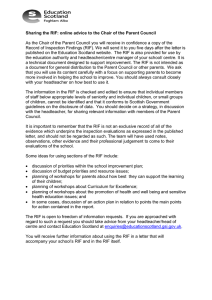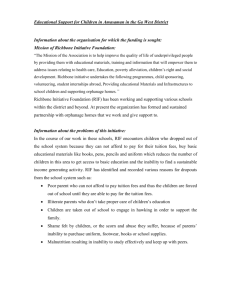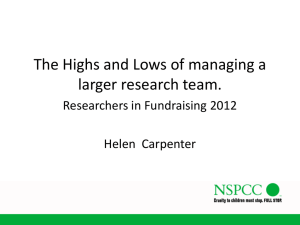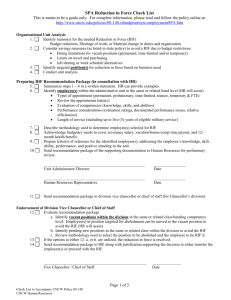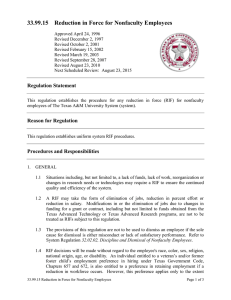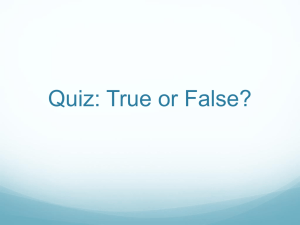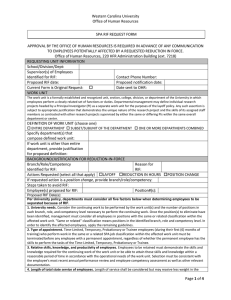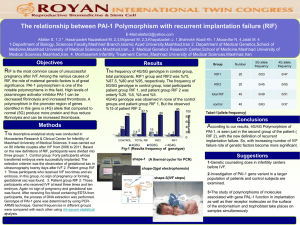RIF Summer - Scholastic
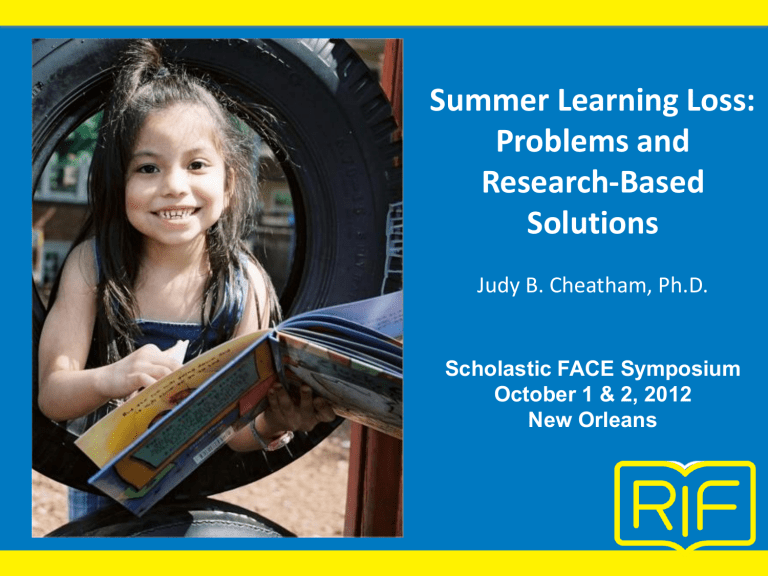
PICTURE
HERE!
Summer Learning Loss:
Problems and
Research-Based
Solutions
Judy B. Cheatham, Ph.D.
Scholastic FACE Symposium
October 1 & 2, 2012
New Orleans
2
RIF Overview
Founded in 1966, RIF is the nation’s oldest and largest children’s and families’ literacy non-profit.
3
RIF Overview
• Vision: A literate America in which all children have access to books and discover the joys and value of reading.
• Mission: RIF is dedicated to motivating young children to read by working with children, their parents, and community members to make reading a fun and beneficial part of everyday life.
• Focus on Children 0-8 years
• Multicultural Initiative
• Parent Engagement
4
Books For Ownership Program Overview
What?
• Book distributions
• Activities that encourage reading
• Family & community involvement
Where?
• 17,000 sites such as schools, libraries, Head Starts, clinics, and community centers
• All 50 states, U.S. territories, and the District of Columbia
Who?
• Organizations serving children with an average of 80% or greater free and reduced meal eligibility
5
RIF Targets At-Risk Children
• Low-income children, particularly in highpoverty areas
- 80% or more eligible for free or reduced lunch
• Military families
• Children with
Disabilities
• Foster children, homeless children, and migrant children
• Children without access to libraries
• Institutionalized or incarcerated children
• Children whose parents are institutionalized or incarcerated
6
RIF Impact in 2011
7
RIF Impact to Date
400 million
new, free books to more than
35 million
children
8
Loss of Federal Funding
30
25
20
15
10
5
0
$24.8 million
RIF's Federal Funding in FY10
$0
RIF's Federal Funding in FY11
9
National Literacy Grant Competition
• For FY11, Congress voted to eliminate the federal funding RIF has received since 1976.
• In FY12, Congress provided $28 million for a national literacy competition through the
Department of Education—half for school libraries and half for national literacy organizations.
10
WHAT THE RESEARCH SAYS ABOUT
THE READING LANDSCAPE
11
71% of children living in poverty cannot read at the most basic level.
12
America’s Literacy Crisis
• In low-income neighborhoods, there is only 1 book for every 300 children.
• 34% of children entering kindergarten lack the basic language skills they will need to learn to read.
• Only 1 in 5 low-income children read on grade level by the end of 3rd grade.
13
What Do We Know About Children and Reading?
• A child from a low-income family enters kindergarten with a listening vocabulary of 3,000 words, while a child from a high-income family enters with a listening vocabulary of 20,000 words.
• 88% of children who have difficulty reading at the end of 1 st grade display similar difficulties at the end of 4 th grade.
14
What Do We Know About Children and Reading?
• 75% of students who are poor readers in 3 rd grade remain poor readers in high school; after 3 rd grade, cognitive demands increase yearly.
• 36% of American 4 th graders read below the Basic level on NAEP.
• Among 4 th graders, 58% of African-American, 54% of
Hispanic, and 52% of American Indian children scored below the Basic level on NAEP.
• 54% of all 4 th graders eligible for free or reduced lunch scored below the Basic level on NAEP.
15
National Assessment of Educational Progress:
The Poverty Achievement Gap
Sources: National Center for Educational Statistics
Note: NSLP = National School Lunch Program (provides free and reduced-priced lunches to children of lowincome families.)
16
LITERACY (reading, writing, listening, speaking) is the VEHICLE to content material,
• Science
• Social Studies
• Mathematics
• Health
• Technology
• Engineering
ESPECIALLY when LEARNING TO READ changes to READING TO KNOW
.
17
Math
China (PRC)
Literacy Issues Can Affect Content . . .
Current State of Affairs: PISA
Science
US
US
18
HERE’S the BIG PROBLEM:
The GAP doesn’t close!
19
Current State of Affairs: Science NAEP
Overall, 65% of 8 th grade students scored at or above Basic in 2011
White
Black
Hispanic
Asian/Pacific
Islander
American
Indian/Alaska Native
Race Gap
Gender Gap
M
F
20
7 Things a Person Needs to Know to Read English:
Back to Basics
1. The alphabet
2. Sounds and symbols
3. Concept of print
4. Vocabulary
5. Spelling patterns
6. Lots of sight words
7. Reflective practice
21
Vocabulary Acquisition by Age 3
Children of Welfare Families
Children of Working Class Families
Children of Professional Families
0 500 1000 1500
22
From Research in the Second Language Field . . .
Vocabulary: BICS vs. CALP
• Basic Interpersonal Communicative Skills
( 2 years to develop for ELLs)
– Develop through social situations in informal school settings (cafeteria, playground, school yard)
Cummins, 1984; Echevarria, Voght Short, 2008
23
From Research in the Second Language Field . . .
Vocabulary: BICS vs. CALP
• Cognitive Academic Language Proficiency
( 5-7 years to develop for ELLs)
– Content vocabulary (Tier THREE)
• Appears in specific areas of knowledge (math, science, social studies, literature)
• Is TIER THREE vocabulary
• Is not used frequently
• Is thus more difficult for learners to internalize
Harmon, Wood, & Hedrick, 2006
24
WHAT THE RESEARCH SAYS ABOUT
SUMMER READING LOSS:
CAUSES AND SOLUTIONS
25
Summer “Slide”
• Learning loss that occurs anytime children are not in school (summer as well as winter, fall, and spring breaks)
• First documented in 1906 , teacher of mathematics
• Subjects most affected – those that rely on skills that require:
- constant repetition
- multiple opportunities for practice and feedback
- with a goal of automaticity
- like reading, writing, math, TIER THREE vocabulary
26
Summer “Slide”
The Loss?
• One month to three or even more of learning from the PREVIOUS school year
The Implication?
• First day of school of new year: some children know half to all the content material for the coming year; other children have lost 1/4 -1/2 year of learning from last year
27
Learning Loss and Socio-economics
• Middle income families – Enrichment activities in the summer:
* parent at home, more educated
* travel
* camps
* bookstore and library in home or neighborhood
*enrichment programs, classes
28
Summer Reading Programs as a Possible Solution to Close the Gap
• Kim and White (2008) study
• To prevent “decay” of children’s reading ability over summer, children need a program with at least the FOUR following components:
29
Four Components of an Effective
Summer Reading Program
1. Access to books (6-8)
* at the individualized (lexiled), appropriate level of difficulty for each learner
* with choice of topic within the lexiled level
2. Scaffolded activities and motivators
3. Professional development
4. Parent involvement
(Kim and White, 2008)
30
Specifically, 2008 Kim and White Study
Found . . .
• Voluntary summer reading intervention program with
* books based on lexiles and student interest
* specialized instruction by teachers, and
* directed scaffolding by parents
RESULTED in 1.7 to 5.1 months of additional learning!
31
Six Barriers to Parental Involvement
Many times,
• Parents do not believe they can help.
• Parents do not feel welcome at school.
• Schools do not provide advice to parents
• Schools fail to alert parents about problems.
• Parents feel intimidated by the school or vice versa.
• Communication is not two-way.
32
Along with the “Usual Suspects”
• Lack of childcare
• Lack of transportation
• Lack of common language/culture
33
New Study (Wilkins et al., 2012)
“Does a Summer Reading Program Based on Lexiles
Affect Reading Comprehension: A Final Report”
• Large scale, multi-districted study
• 8 books, matched to reading level and interest area, chosen at the first of the summer
• Weekly postcard to parents
34
RESULTS
• Program did not “move the needle” in terms of improving reading scores
• Wilkins et al. concluded that, based on what research says, this one did NOT include scaffolded materials, teacher staff development, multiple summers, parent involvement, student responses to texts
35
RIF - proposes a program that focuses on
SUMMER READING as part of a “cradle to career” school/family literacy initiative featuring
• Books
• Activities
• Motivational events
• Motivational collateral
• Staff Development
• Parent involvement
• Parent contact
36
Books
• Choice and lexiles
• 6-8 per child, per summer
• Based on common core
– Half narration
– Half exposition
• STEAM-themed
– Tier 3 vocabulary
– Cradle to career focus
37
Teachers
In-services and continuing focus on:
• Working with parents
• Helping children choose books
• Using the activities in the classroom and with parents
• Common core alignment
• Exposition vs. narrative
• Tiers 1,2,3 vocabulary
• Active learning
38
Parents
• On-going affirmation about their roles
• Special meetings at Summer and Fall Back to
School Reading Celebrations
• Special attention to parent activity sheets and literacy calendars
• Weekly contact during summer reading, 6-8 weeks, via ways parents choose (text, phone, email)
39
Activities for Teachers, Parents, CBOs
Developed according to best practices
• Prediction, reflection, content connections
• Reading, writing, listening, speaking
• Multiple opportunities for learning
• Extension activities cross content boundaries
(tier 3 vocabulary) and promote active learning
40
Distribution
1. Family summer celebration kick-off
Book-bag and motivational/educational materials, including diary with both directed and free writing prompts
5 books, arranged according to topics and lexiles on tables
Food*
Parent meeting, stressing parent’s role in children’s learning and motivational activities
41
Distribution (cont)
2. Weekly contact with parents, via the method they choose (text, email, phone call) by the school-based coordinator
42
Distribution (cont.)
3. Four-week check-in
3 books, on tables
Flexible hours
Another face to face time to touch base with parents
Additional scaffolded materials
43
Two Award-Winning Expository
Texts from Scholastic
44
45
46
Parting Thoughts and Suggestions:
• Whole school improvement
• Multiple year program
• Coordinator should be local and know parents
• Pre-test and post-test
• Keep your eyes on yearly progress from year one
47
And That Will Give Us . . .
• NOT the end;
• Book People Unite!
48
